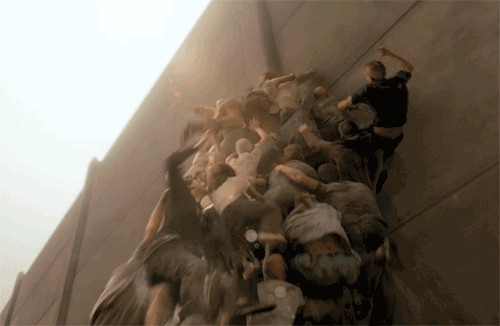Tags
#BlackLivesMatter, #MissingBlackGirls, #MissingDCGirls, #WhiteLivesMatter, Contrast, Girls of Color, Intersectionality, Marginalization, Montgomery County MD, News Coverage, Racial Privilege, Rape, Rockville High School, Trolls, Twitter

World War Z gif of horde climbing a wall (much like the way Americans see immigrants regardless of status), March 26, 2017. (http://reddit.com).
I’m sure I’m not the only one who noticed the stark, sad, and anger-inducing contrast between two events in the past couple of weeks. One involved the alleged rape of a 14-year-old girl by two undocumented immigrants (ages 18 and 17) at Rockville High School. The press gave this incident coverage on a local and national scale. So much so that xenophobic, anti-Latino Twitter trolls got involved.

Screen shot of tweets regarding Rockville High School rape, March 26, 2017. (http://twitter.com)
The proverbial “they” used the arrests as evidence of an immigration form of World War Z, in which angry hordes of the undocumented pour through America’s border with Mexico, raping, pillaging, and drugging up White (and mostly female) innocents. “Build the wall,” “illegals,” and “liberals” all became a cabal of iniquity in the (White) America First camp. What about the 14-year-old girl, the counseling she may need, or security issues at Rockville High School in general? Instead, two almost adult teenagers are a stand-in for immigration policies and 11 million undocumented persons. But what else is new?
On the other end of the spectrum has been the lack of coverage of missing Black and Latina girls in the DC area — in fact, in many parts of the US. So little has been even the local coverage that it took a tweet (one that I retweeted myself) two weeks ago for DC affiliates to pay closer attention.

Screen shot of retweet on 8 missing Black girls in Washngton, DC, March 12, 2017. (Twitter via @BlackMarvelGirl).
National coverage only kicked in when someone erroneously posted on Instagram that 14 Black and Latino girls had gone missing in the DC area in a 24-hour-period. True or not, there was no corresponding outrage over even the mere possibility that girls of color could have been kidnapped, trafficked, raped, or murdered as part of a crime spree. Though the facts of this particular Instagram posting were skewed, there’s no debate or daily concern for what happens to youth of color, especially girls of color, in the US. When confronted with the fact that 37 percent of America’s missing children are Black (Blacks are 12.4 percent of the US population), the excuse has been that most of them are “runaways.” And with that kicks in all kinds of racist and misogynistic assumptions. “The poverty and crime and drugs” got to be too much. “They’ve been exposed to more,” and therefore, can handle being on their own. “They’re sexually promiscuous” anyway, so let them run off with older men.
No one considers the why. In this case, why would these girls run away? Physical and sexual abuse at home, leading to vulnerability outside the home to human trafficking, rape, prostitution, or run-of-the-mill homelessness and poverty. No matter how one looks at this, this should be national news. That is, if America wasn’t primed to see only White kids as innocent.
Which brings me back to Rockville High School. No one knows the identity of the 14-year-old rape victim. But based on the Twitter trolls and the Washington Post comments section, most assume the girl is White. It proves a few things, especially for me as a Montgomery County (MD) resident. One, that my upper middle-class neighbors would turn on me in a second if I met anything approaching a criminal stereotype. For them, I would represent the alleged cultural deficiencies of 44 million other Blacks. Two, that for all their so-called liberal ideology, most White Americans are center-right, no matter where they live. They will turn a tragic incident into a racial or xenophobic referendum on millions of people faster than you can say “white on rice.” Three, only White lives matter and always matter to Whites, especially when put in contrast to the lives of people of color, immigrant or native-born or otherwise.
Show me you’re a liberal by embracing the truth of your own racial privilege. Show me you’re a liberal when you have to risk ostracism from your neighbors about defending the rights of undocumented immigrants as alleged rapists or decrying how the media doesn’t cover missing, exploited, and abused Black and Latina girls. Don’t tell me you’re a liberal, when it’s obvious your racism, sexism, and xenophobia is showing.










